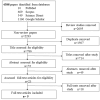FAP-Targeted Nanoparticle-based Imaging in Cancer: A Systematic Review
- PMID: 39175559
- PMCID: PMC11336055
- DOI: 10.31661/jbpe.v0i0.2404-1754
FAP-Targeted Nanoparticle-based Imaging in Cancer: A Systematic Review
Abstract
Background: Fibroblast Activation Protein (FAP)-targeted nanoparticles (NPs) are designed to accumulate in cancerous stroma. These NPs hold promise for imaging applications in cancer therapy.
Objective: This systematic review aimed to comprehensively explore the use of FAP-targeting NPs for cancer diagnosis through different imaging modalities.
Material and methods: This systematic review followed the framework proposed by O'Malley and Arksey. Peer-reviewed studies were searched in the Scopus, Science Direct, PubMed, and Google Scholar databases. Eligible studies were selected, and data were extracted to investigate the FAP-targeting NPs in imaging. The Preferred Reporting Items for Systematic Reviews and Meta-Analyses (PRISMA) guideline was also utilized to present the results.
Results: Five studies met the specified inclusion criteria and were finally selected for analysis. The extracted data was classified into two categories: general and specific data. The general group indicated that most studies have been conducted in Mexico and have increased since 2022, and the specific group showed that colorectal cancer and Nude mice have received the most research attention. Furthermore, FAP-targeted NPs have demonstrated superior diagnostic imaging capabilities, even compared to specific methods for each cancer type. Also, they have been safe, with no toxicity.
Conclusion: FAP-targeted NPs using different ligands, such as Fibroblast Activation Protein Inhibitor (FAPI), can accurately detect tumors and metastases, and outperform specific cancer peptides like PSMA in cancer diagnosis. They are also non-toxic and do not cause radiation damage to tissues. Therefore, FAP-targeted NPs have the potential to serve as a viable alternative to FAP-targeted radionuclides for cancer diagnosis.
Keywords: Fibroblast Activation Protein (FAP); Imaging; Molecular Imaging; Nanoparticles (NPs); Neoplasms.
Copyright: © Journal of Biomedical Physics and Engineering.
Conflict of interest statement
None
Figures




References
-
- Valkenburg KC, de Groot AE, Pienta KJ. Targeting the tumour stroma to improve cancer therapy. Nat Rev Clin Oncol. 2018;15(6):366–81. doi: 10.1038/s41571-018-0007-1. [ PMC Free Article ] - DOI - PMC - PubMed
-
- Micallef L, Vedrenne N, Billet F, Coulomb B, Darby IA, Desmoulière A. The myofibroblast, multiple origins for major roles in normal and pathological tissue repair. Fibrogenesis Tissue Repair. 2012;5(Suppl 1):S5. doi: 10.1186/1755-1536-5-S1-S5. [ PMC Free Article ] - DOI - PMC - PubMed
-
- Messerschmidt SK, Musyanovych A, Altvater M, Scheurich P, Pfizenmaier K, Landfester K, Kontermann RE. Targeted lipid-coated nanoparticles: delivery of tumor necrosis factor-functionalized particles to tumor cells. J Control Release. 2009;137(1):69–77. doi: 10.1016/j.jconrel.2009.03.010. - DOI - PubMed
Publication types
LinkOut - more resources
Full Text Sources
Miscellaneous
